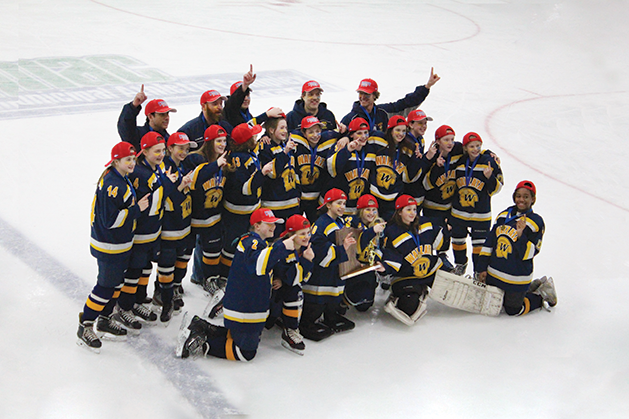
The girls, parents and coaches of last year’s Wayzata Blue U12 B State Championship hockey team call themselves a “hockey family.” And it’s true — the tightknit group tends to finish each other’s sentences while they laugh at inside jokes. “You spend so much time together, there’s just great camaraderie and bonding, and an amazing support network of families,” Nicole Sanders says.
Finding Hockey
Nicole’s daughter, Raina, 12, started playing hockey when she was going into second grade. She initially played soccer and participated in swimming, but half her family were hockey players. “They’d try to convince me to play and I didn’t really want to, but I was kind of getting bored with soccer, and then a friend was playing in first grade and I tried it and really liked it.” She loved hockey so much that she quit everything else and just focused on her new favorite sport.
This concentration is common among the girls in this group. “I used to do swimming and I kind of got bored with it and told my dad I wanted to try hockey, ’cause all my friends played hockey,” Tatum Pfleider, 13, says. Ella Englund, 13, started when she was 5, and talks about a lot of her family members playing hockey. Not her little brother, though, she notes. He doesn’t like to skate, at least not yet, but spends so much time around the team that he’s become their unofficial mascot. Ava Abrahamson, 12, has a family history of hockey, too. “My family kind of grew up playing hockey and my dad passed it down to me and my sister,” she says. Her dad, Brett Abrahamson, coaches the team.
“That’s the biggest thing — these girls just love coming to the rink and hanging out with their friends and playing a game that they all love,” Brett says. His daughter agrees. “We still hang out, too, besides the hockey season. We got that close that we want to hang out even more,” Ava says. When they get together outside of practice, their focus is still hockey. “We’re watching hockey movies: Miracle on Ice, Mighty Ducks.”
“If we’re not playing, we’re watching it on TV or watching others play,” Raina says.
A Commitment
The girls’ commitment to hockey is no small matter. Some of them play year-round, and during their regular season they practice five to six times a week. They also practice plenty more on their own .
“Our whole lives rotate around our kids’ sports,” Andrea says. “There’s a lot of driving involved.” The whole groups laughs at this. “A lot” might be an understatement, with three to four away tournaments between October and March, but none of them would change a thing.
“It takes up all your time and sometimes we got to miss school,” Raina says to more laughter.
Andrea doesn’t mind hockey being the center of her family’s universe. She points out that Wayzata had a plethora of boys’ hockey teams, but just three U-12 girls’ teams last year. “The sport has been growing, and it’s so awesome,” she says. “I grew up loving hockey and went to North Star games with my dad, grew up loving the game but never had an opportunity to play it. To see our daughters play is thrilling.” She and the other parents are gratified the professional women’s hockey team gets paid now and says this is a future the girls aim for, including getting involved with youth programs when they’re adults and helping further the sport that they love.
This is a trend among these families — hockey is a love they pass down to their kids. Brett is a former University of Minnesota hockey player, Nicole’s husband, Craig, is also a coach. “Those guys are very dedicated,” she says. “They’re here four times a week for practice plus a game or two, plus tournaments. Coaches are dedicated, but they love it. These are guys who grew up playing the sport and they love it.”
A Team Effort
Brett points out that it’s a group effort to keep the team going. “Parents are involved; everyone pitches in and brings water, Gatorade, hors d’oeuvres, salad, potluck.” Dottie was the team manager last year, a role that included everything from making hotel and food reservations for 50 people when they were playing out of town to bringing door signs to the hotels. The signs were fun and useful items, decorated with team name, players’ numbers, the trojan logo and more; this way the girls could find each other’s rooms.
Parents ordered shirts so the girls could look like a team even off the ice; there must be a mom in the locker room at all times, parents run the penalty box and score board. “There are a lot of moving parts, so everyone’s actually contributing,” Dottie says.
And then there’s the cheering. Ava and Tatum talk about a cheer their families used with the catchphrase “unleash the beast,” displaying a shirt they printed that features an unidentified beast. “It’s a werewolf — or a bear — just some kind of beast,” they agree. Whatever it is, it’s fierce.
Though the beast’s classification is unclear, the competitive spirit it represents is clearly very strong in the group. “If you’re playing a game against a team you really don’t like, you just really want to beat them for the bragging rights,” Raina says. The biggest game last year was the one against the other Wayzata team, because nobody wanted to head back to school as the losing team. But they’re all quick to agree that good sportsmanship is important. “We’ll still hang out with them and talk to them no matter what the score,” Ava says. After all, they do share the same love for hockey.
How These Players Improve Their Game
Raina says they do dry-land practice downstairs at the Plymouth Ice Arena, where they skate on a treadmill designed for use with skates doing stick handling, shooting and agility training. They also do plyometric training at the arena involving quick movements designed to increase power.
They also practice stick handling and shooting at home. “I like to kind of make up my own drills,” Tatum says. Ava talks about drawing out hockey drills on paper, something the teammates have done together outside of practice.
A lot of the girls have nets at home and the teammates meet up at rinks on ponds, sometimes even after a game or practice.
“I actually did training with a private trainer this summer once or twice a week,” Tatum says, “and it helped a lot because I got stronger and she helped with my agility and stamina.” Raina does some studio yoga for strengthening because they use so many muscle groups in hockey. No checking is allowed, but they do get bumped and fall so it’s important to stay strong.
The girls always try to eat healthful food, but are extra aware before a game. “Sometimes for really important games, we all went out to eat the night before as a team to carb up with pasta,” Ava recalls. “Sometimes we get pizza after games, but that would never happen before a game, just pasta or protein.” And hydration is key. A parent is always carrying a big cooler of water and passing it out to everyone, so they’re never without water.









